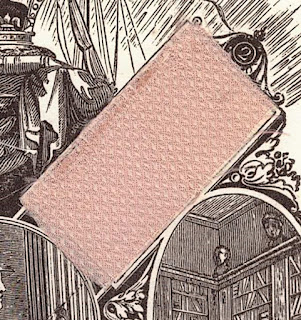Here’s another post in our ongoing series on Regency fabrics.
As I have in previous posts, I’ll be examining actual fabric samples glued into
several earlier editions of Ackermann’s Repository, samples supplied by
the manufacturers and published by Ackermann in order to boost the British
cloth-making industry at a time when exporting British goods to Europe was almost
impossible because of the Napoleonic war. I'll give you a close-up scan of each
sample, the published description if available, and my own observations of the
color, weight, condition, and similarity to present-day materials, to give you
as close a picture as possible of what these fabrics are like.
Today’s four samples are from the May 1813 issue of Ackermann’s Repository. The overall
condition of my copy is excellent; the page itself is free of foxing and is only slightly toned. Two of the samples (numbers 3 and 4) shows some foxing, but overall they’re in very good condition. It's interesting to note that three of the fabrics shown are intended for morning or "home costumes," rather than for more public attire.
Here we go!
No. 1. A Smolensko striped imperial washing silk, calculated for morning or domestic wear. It is either formed in a high wrap, with full sleeve, and falling collar of lace or needlework; or in the round robe, of a demi height, bordered at the several terminations with jonquil satin. It is sold at about one guinea and a half per dress, by Mr. Millard, Cheapside.
My comments: A very finely woven fabric with white background very flat, though the yellow chevron chains have a nice sheen. It would definitely require lining because of its sheerness (unless it was for a summer dress, and even then...) Charming!
No. 2. A delicate figured sarsnet, of Persian lilac, or blossom colour, designed for the spring cloak, spencer, or pelisses, but is equally appropriate for the evening bodice or robe. Articles of this material admit only of fancy trimmings of the same nature, or those of plaited net, feather trimming, or thread lace. It is manufactured and furnished by Messrs. Sutton and Meek, 53, Leicester-square.
My comments: It is difficult to tell if the color has changed or faded, but my sample is of a soft grayish-pink that is quite attractive. It is a little sturdier than the previous sample, but not much, and would definitely require lining if made into a cloak or pelisse, if only to give it some body. The pattern is pretty, with little diamond-shapes standing out from the background, and a lovely silky hand.
No. 3. A grey and black printed striped muslin, admirably calculated for that slight sort of mourning which is usually adopted at the conclusion of a court mourning; formed in morning wraps, or high round robes, trimmed with black love ribbon, with hats of black chip and feathers, or black lace hoods, or mob caps; it composes a very pretty morning dress, or home costume. It is sold by Messrs. T. and J. Smith, Tavistock-street, Covent-Garden.
My comments: Again, I expect this has changed color in the intervening 200+ years because my sample is now a quite lovely sky blue color and not at all appropriate for mourning! Also very light-weight, even with the stripes of slightly heavier thread woven in.
No. 4. A buff-coloured Chinese silk, calculated also for domestic wear, admitting of no trimming so appropriate as those of satin of the same colour, plaitings of net, or borders of lace. This article is furnished us by Messrs. George & Bradley, Holywell-street, Strand.
My comments: It would not be a stretch to call this "silk muslin"--the weave, texture, and weight are that of a good quality cotton muslin, but the silk gives it a sheen not seen with a cotton fabric. Again, a good summerweight fabric, though it would require lining or an underdress.
What do you think of this month’s fabrics?























